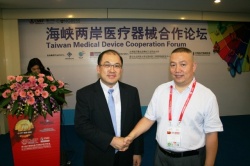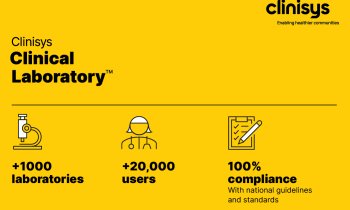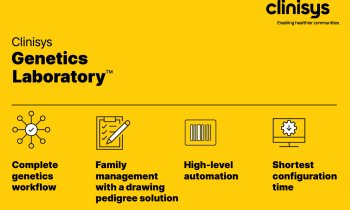Key trends from CMEF in Xiamen
Health insurance catching on, diagnostics of the future on the path towards integration
Crowds of hospital delegates flocking in to Xiamen on the first day of CMEF had already suggested that the event will be welcoming more than the roughly 60,000 delegates expected to participate


The second day saw another enormous attendance and the start of accompanying conferences.
So what is the situation in China’s healthcare sector today? Until recently, the Chinese had saved an enormous part of their income to prepare for any health issues requiring, for many, payment out of pocket. In order to ensure access to care and to foster a more dynamic domestic market to enable the economy to grow, the Chinese government had implemented a health insurance scheme. This policy is indeed showing its effect, outlined Nat Whitney in an information briefing and networking session in Xiamen. His consultancy with its focus on the IVD sector in China has been tracking, e. g., authorized patient charges for lab tests based on government guidelines. “The figures we have established show that the broadening of health insurance coverage is really happening”, said Whitney, “and coverage goes deeper, including more expenses”.
New safety net for care catching on
What his team’s research has also shown, however, that there are variations as to how the pricing guidelines are applied: “Prices differ by region, and they may depend on whether domestic or foreign reagents are used. There are also differences based on the technology used, such as ELISA vs. chemiluminescence.” Until the end of the year, a standard per-test fee disregarding the technology involved will be implemented, with charges set at a medium level. Whitney summarized his observations, “it is evident that today, the Chinese population is embracing this new safety net designed to help them when they get sick.”
Precision Medicine requires integration of diagnostics
During recent years, organizers of CMEF had successfully provided a platform for educational conferences to further enhance the appeal of the tradeshow. In Xiamen, several conferences were dedicated to advances in imaging and further fields. The China International Leadership Summit for Strategic Studies in Imaging (CSSI 2013), e. g., brought together leaders from imaging, medical physics, and IT in hospitals with key industry representatives for an exchange of information and opinions.
Currently, the general challenges in providing care and, in particular, in imaging may be on quality and efficiency. “But more importantly, we are finding tumours generally too late”, said Prof. Dai Jianping, naming breast cancer as an example; there is a huge percentage of dense breasts in the Chinese population, which is a cause for high risk. The medicine of the future will therefore need to be predictive, preventive, personalized, and participatory – this is the transformation envisaged by the professor of Radiology, Capital Medical University affiliated Beijing Tiantan hospital, VP of the Chinese Medical Association (CMA) and chairman of CSSI.
Precision, according to the expert, needs to come first, preceding personalization. What has to change to allow for increased precision leading to better patient outcomes, and to avoid the significant waste of diagnostic activities recently made public by the Institute of Medicine (IOM)? Certainly, further improvements in physics, chemistry, and physiology are fostering development, e.g. in ultrasound, contrast-enhanced MRI, tomography, markers, and genomics testing – but the challenge reaches beyond that: “When it comes to diagnostics, conventionally there has been a clear distinction between radiology, nuclear medicine, IVD, and pathology – in China just like elsewhere”, underlined Prof. Dai in Xiamen. Integrating the expertise from imaging including CT, MRI, ultrasound, and nuclear medicine, as well as chemistry and physiology will be the necessary step to take: “Lab results will tell us what’s wrong; imaging will tell us where the disease is located; and pathology will add information at the genomic or molecular level”, summarized the expert. “Today, these services are not integrated, which has a negative impact on precision and, in the end, patient outcome”, Prof. Dai continued. “Exam and test results will need to be organized in a diagnostic pathway optimized depending on each organ, and the resulting report will need to combine the information acquired.”
Diagnostic pathways and new structure of departments
This requires restructuring of departments and transforming the education of physicians who will need to learn from the other fields concerned. In a first phase of this transformation, bringing the various players together in tumour boards which should really start at the beginning of the diagnostic workflow will help, explained the expert. In future, integrated diagnostics will be carried out by staff with a qualification in multiple disciplines in new integrated diagnostic departments – and IT will lay the foundation, according to Prof. Dai. CSSI has started implementing this trend by adding physics and IT competence; and a new medical society is emerging in China which will support this major trend aimed at providing better care.
R & D collaboration with Taiwan
The Economic Cooperation Framework Agreement (ECFA) between China and Taiwan has been providing the platform for increased interaction in the medtech sector. At CMEF, a seminar brought together companies from mainland China and from Taiwan. “Taiwan has an enormous research and development potential to offer to China”, pointed out Hsu-Wei Fang, PhD, who heads the Healthcare Industry Development Association Across the Strait (HIDAS). “But our market is small. An additional benefit is that we speak the same language. Companies in Taiwan will certainly profit from the collaboration with manufacturers in the huge Chinese market.” Furthermore, the island serves as a bridgehead to China for SMEs from around the world, facilitating market entry. “China is in need of research and development expertise”, commented Feng Jiang M.D., CEO, China Association for the Medical Device Industry (CAMDI); “the cooperation in R&D and sharing of patents with Taiwanese companies can very much foster the further development of our medical devices market here.”
European Hospital’s upcoming third report from the CMEF autumn show in Xiamen will present highlights from the exhibition floor.
by Michael Reiter
05.11.2013











